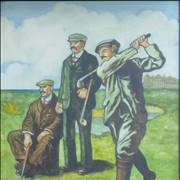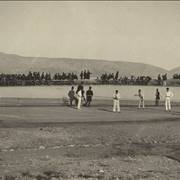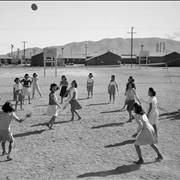Non Contact Sports
Non-contact sports are those who not only forbid contact between competitors but sets up regulations in such way that players don’t even have a chance of sharing the same physical space one with another. If physical contact somehow occurs when players accidentally leave their predefined play space and create an out-of-bound offense, they are handed a strong reprimand or even disqualification. To achieve full separation between competitors, individual play sessions in non-contact sports are either made to be sequential (one player competing after another, for example in bowling or darts) or if all players need to compete at the same time, they are separated by clearly marked lines (in running) or playfield boxes (like in tennis).
While the majority of the non-contact sports involve individual players who are tasked to showcase their skill, endurance, athleticism or tactics, some of them can also be team-based. Examples of such sports are volleyball, tennis (doubles) and rowing, and in all of them, rules forbid both contacts between teammates and opponents. Most popular non-contact sports that promote individual play are tennis, golf, bowling, pool, swimming,
Golf
Golf is a popular club and ball sport where players use the least possible amount of club hits to drive balls into a series of holes on large open-field courses. While many other club and ball sports are played on predetermined field sizes, each golf course is different and offers players unique landscaping challenges to overcome while hitting balls. This unique approach allows players to showcase their skills in unknown environments rather than relying on a standardized playing field.
While recreational golf is played until all players finish driving balls into nine holes, professional matches use arranged progression of 18 holes. To make the final part of each run easier, an area around the hole is arranged to be flat with nicely trimmed grass, which is similar to the starting position (called the tee box). Each player can bring up to 14 clubs on the field in a carrying bag, while a tee shot (hitting a ball placed on a small stand) is usually allowed only for the first stroke on each hole.
To enhance their play, professional golf players can take advantage of various club shapes, and they enhance their shots with golf shoes with metal or plastic spikes and use several stroke hit styles for both long and short-range shots. The final distance to each hole is usually covered with a precise short-ranged put shot.
History of Golf
The history of golf can be traced to several old outdoor games played on several continents. Still, its modern form comes from 15th-century Scotland, where the game eventually spread south to England, France, and the rest of the world, where it remains popular as a professional sport and fun activity.
Bowling
Bowling is the largest and most popular form of throwing sports, in which players in both leisurely or competitive environments throw a throwing ball towards a target, usually consisting of pins at the end of a long lane. In the most popular type of this game, called “pin bowling,” the goal consists of 12 pins and 12 throwing runs, possibly gathering 300 points if all twelve throws were perfect. An alternative version of bowling, called “target bowling," consists of throwing the ball or another object so that it stops moving as close as possible to the target. In different countries, bowling can be identified as pin bowling (in the United States) or target bowling (United Kingdom).
Traditional pin bowling is today practiced in five distinct types of play - most popular Ten-pin bowling, Nine-pin bowling, Candlepin bowling, Duckpin bowling, and Five-pin bowling. Pin bowling is usually played in indoor environments on wood or synthetic surfaces. In contrast, target bowling is often played outdoors on natural or trimmed lawns with balls that are either smaller or eccentrically weighted.
As of 2017, bowling is most popular in the United States, where over 70 million people play this sport leisurely and competently each year.
History of Bowling
Bowling is an evolution of hundreds of sports played during antiquity, the middle ages, and Renaissance Europe. By the 19th century, bowling-based sports became increasingly popular indoors and outdoors, and the modern version of the sport crystalized and became popular worldwide.
Surfing
Surfing is the most popular surface water sport in the world. It allows people (called surfers) interested in leisure entertainment and professional competition to use their body (belly or knees) or lightweight board to ride on the forward-facing face of a moving water wave toward the shore. Most commonly, waves suitable for water surfing can be found near ocean shores, but in some cases, water surfing is also possible on lakes and rivers. Surfing is also possible on artificial waves created by boat wakes or in artificial pools purposely built to create large ocean-like waves.
While body surfing is possible and is practiced worldwide, the modern term “surfing” often signifies a stand-up type of surfing where a surfer stands on several types of boards. These boards come in several types, most commonly being surfboards, longboards, paddleboards, and bodyboards, all made in different sizes and shapes.
Safety equipment is rare in surfing, and the nature of the wave size, speed, and type of shore terrain can sometimes lead to injury or death. The most common dangers of surfing include drowning, collisions with natural objects, other surfers or their equipment, injuries or death caused by marine life, rip currents that may lead surfers far away from the shore, and collisions with the seabed or rocky shore.
As of 2017, the largest ocean wave that a surfer successfully rode was 78 feet (23.8 m) high.
History of Surfing
Surfing was practiced for centuries by Polynesian cultures, but it became popular in western culture in the early 1900s when surfing officially came to the beaches of California. During the rest of the 20th century, board and body surfing on ocean waves became known worldwide as a popular summer activity and professional sport.
Tennis
Tennis is a very popular racket sport in which two players (or a team of two players in a doubles match) use tennis rackets to strike a hollow rubber ball across the net that separates two marked playing zones into the opposing court. After the ball crosses the net, the player at the side of the ball can hit the ball either while it is in the air or after it has bounced the ground once inside the playing zone. A single point is scored if a player manages to strike the ball so that the opponent cannot strike a ball for a valid return.
Originally formed as an alternative to a medieval handball sport played indoors, outdoor tennis in its modern form took England by storm in the 2nd half of the 19th century under the name of “lawn tennis.” By the early 20th century, it became an Olympic sport. It played all around the world, with rules of 19th-century lawn tennis managing to survive with little changes (such as the introduction of the tiebreak in the 1970s, the point challenge system, and electronic ball tracking).
Today, tennis is played by dozens of millions of recreational players, and professional tournaments have all adopted an open approach, in which all tennis tournaments (including four Grand Slam “majors” - Australian Open, French Open, Wimbledon, and US Open) accept players from all territories. International Tennis Federation (ITF) governs modern rules and tournament oversight.
History of Tennis
Originally invented in the 12th century under the name royal tennis (or “real tennis), modern tennis first emerged as a popular sport in the 16th century when rackets were first developed. With the popularization of the game in England and France, tennis soon became known worldwide. In 1900, professionals and national teams started competing in large worldwide tournaments.
Volleyball
Volleyball is a popular ball sport in which two groups of six players toss the ball between each other across a net. Each team can hit a ball three times before being forced to send the ball to the opposing team, and points are won if one team fails to keep the ball in the air or fails to send the ball across the net. A single player cannot touch the ball twice during a single possession, and usually, the first two touches are used to set up a powerful attack move that will send the ball quickly toward another team. Sending a ball outside the opponents playing court is considered a penalty, as is touching the net with hands or bodies. The ball can touch the net anytime except during the initial serve when the serving team has one chance to repeat the serve.
A successful volleyball player needs to learn proper play tactics for team play and a wide array of moves for serving, safely receiving fastballs, passing, setting up attacks, jumping attacks, blocking, and digging.
Volleyball is a non-contact sport in which players are discouraged by rules from coming in contact with the opposing team and from placing their feet on the opposing court.
After being created in 1895 by William G. Morgan, volleyball's popularity rose quickly, eventually becoming a part of the Olympic Games in 1964.
History of Volleyball
Created in early 1895 under the oversight of William G. Morgan, volleyball first became a pastime of YMCA members and quickly a popular sport in the entire United States. With the ratification of more widely accepted rules, the formation of the first international federation, and the inclusion of this sport in the Summer Olympic Games in 1964, volleyball morphed into its modern form.





